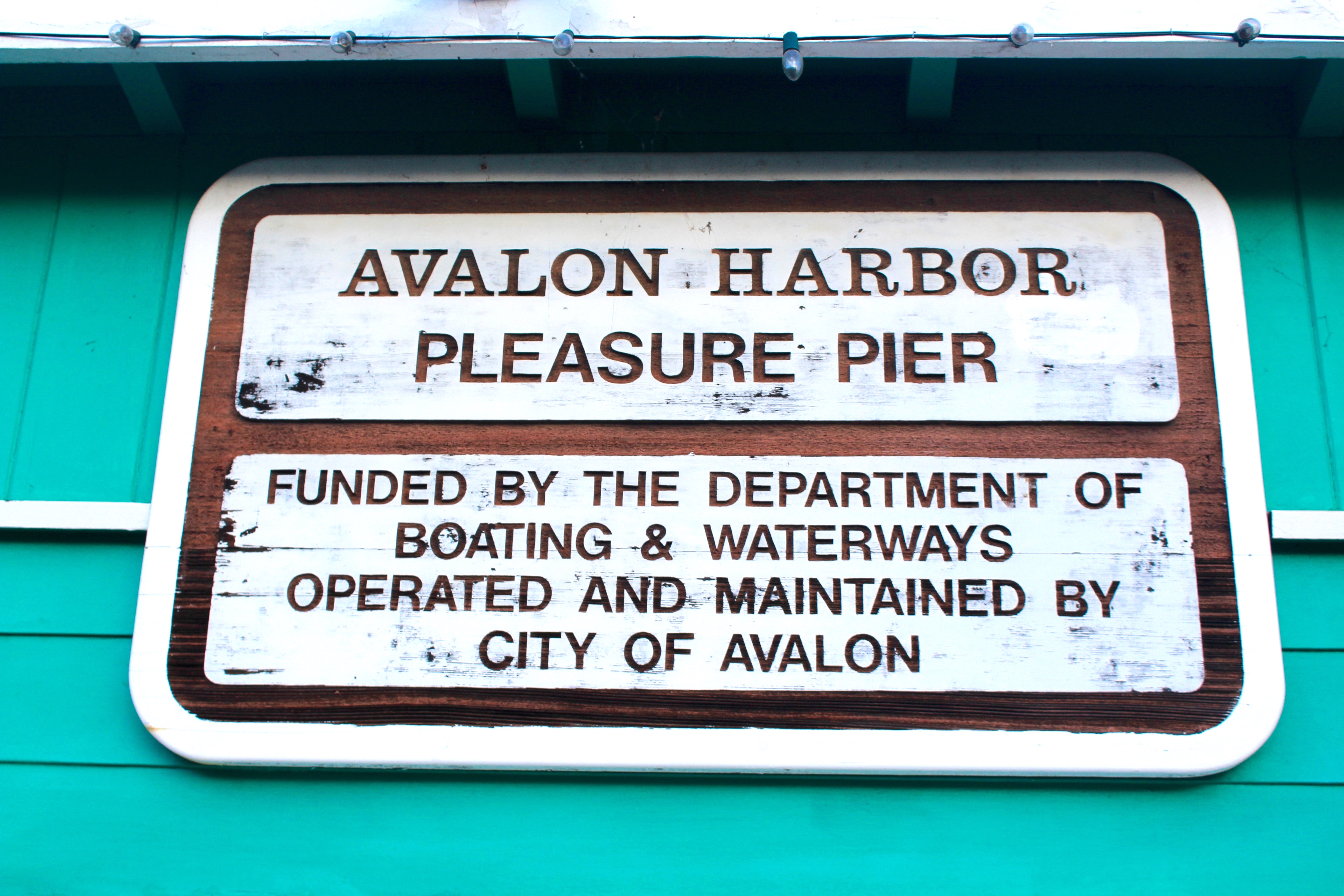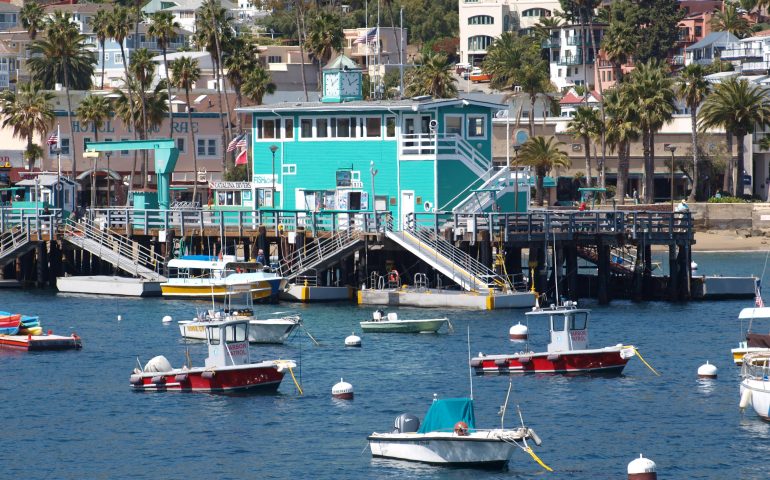Shatto saw Avalon as a vacation destination and soon set up a steamer service to the mainland. To house the visitors, Shatto built the Metropole Hotel along Avalon’s shoreline, while he also began to sell tiny, inexpensive lots. Tents were erected as vacation cottages on many of these lots and Avalon soon had a tent city (dubbed “Catalina’s White City” by newspapers), a precursor of sorts to those that would be established at Coronado, Long Beach, Redondo and other seaside cities. However, echoing the boom and bust nature of real estate in southern California in the late 1880s and early 1890s, Shatto went broke, defaulted on his loan, and the island was returned to the Lick estate.
In 1892 the Banning brothers of Wilmington (William, Joseph and Hancock) bought the island from the Lick Estate. They continued the work to make Catalina a prime destination spot for tourists. They established the Santa Catalina Island Company in 1894 and began to improve the town. They built a dance pavilion, an aquarium, and enlarged the Steamer Wharf. Twice they enlarged the Hotel Metropole (1893 and 1897). The tent city, located on a tree-less plain, now saw avenues planted with eucalyptus to provide shade. The sewer system was improved and an electric lighting plant established. Within time the tent city had six hundred tents and 175 cottages, all wired for electricity.
How happy the children were to land at the little town of Avalon, and to know that they were to have a month at this beautiful place! They hurried down to the beach and their first choice of amusements was the glass-bottomed boat. These boats have “water-telescopes,” which are only clear glass set in boxed-in places. The glass seems to make the ripples still, so that you can look down, down to the bottom of the ocean, twenty or thirty feet below you. The boatman rowed the children out in the bay, where the water, now green, now blue, was always clear as crystal. On the rocks and sand at the bottom starfish and crabs crawled slowly along or clung to some stone. The purple sea-urchins, queer round-shelled creatures covered with thorny spines, crowded together, and the ugly toad-fish hid in the green and brown seaweeds. Blue, purple, and rainbow-colored jellyfish floated on top of the waters, while gold perch with red and green sunfish swam through the seaweed “like parrots in some hot country’s woods,” Retta thought. In the shallow places on the rocks those curious sea-flowers, the anemones, looked like pink or green cactus blossoms. The children never tired of the water-telescope in all their stay at the island. At night the warm ocean waters seemed on fire, since they are full of very tiny, soft-bodied creatures, each of which gives out a faint, glowing light. Every day the fishermen brought in new and strange fishes. The black sea-bass, heavier than the fisherman himself and longer than he was tall, were wonderful, and they could hardly believe that such big fish were caught with a rod and line.
—Ella M. Sexton, Stories of California, 1903
By 1913 Avalon had a summer population approaching 10,000 people and elaborate plans were in the works to improve and enlarge the facilities even further including a new hotel, the Hotel Saint Catherine.
Improvement was needed since competition for the tourist dollar in SoCal was fierce. Abbot Kinney’s Venice Pier and Fraser’s Million Dollar Pier in nearby Ocean Park had long attracted throngs of people from Los Angeles. In addition, Henry Huntington was now running his electric “red cars” to Redondo Beach where he had built the world’s largest plunge, a huge pavilion, and various attractions along El Paseo (not even counting Redondo’s long-time famous fishing wharves). By 1909 Huntington was attracting a million visitors a year to Redondo Beach, by 1910 two million. Competition was also fierce with Long Beach given its huge Pine Street Pier and Pike Amusement Zone.
The trip to Catalina was longer and more expensive. People wanted better and better attractions and facilities and the Banning’s planned to provide them. Their dreams would end with the huge fire that swept through Avalon on November 29, 1915 destroying much of the town.
Debts related to the fire, as well as a dip in tourism during World War I, meant a decline in revenue for the brothers and in 1919 they sold shares of their holdings to various people. William Wrigley Jr., the chewing gum czar, bought the controlling interest.
Wrigley and his family would spend millions of dollars over the next 50 years developing Avalon and Catalina. Additional steamships were added to Avalon’s fleet in the early 1920s (the SS Avalon and SS Catalina), 1929 saw Catalina’s Casino open, and Wrigley brought his baseball team, the Chicago Cubs, each spring to Avalon for their spring training.
In 1932, following the death of his father, Philip K Wrigley took over the Santa Catalina Company and continued to improve the infrastructure of Avalon. Tourism remain a healthy industry excepting the World War II years when Catalina was closed to tourists and used for military training.
In 1975 Philip Wrigley deeded the Wrigley shares in the Santa Catalina Company to the Santa Catalina Island Conservancy. The conservancy maintains about 88 percent of the island outside Avalon and has done so since the mid 1970s.
The Santa Catalina Company still controls most resort properties and operations in the City of Avalon. Included are the Casino Ballroom, Catalina Island Golf Course, the Descanso Beach Club, the country club and the interesting new museum on Metropole Street.
A number of piers have graced Avalon’s Harbor since the late 1800s. Records talk of piers in the bay as early as 1895 and mention a fishing pier in 1905. The Green Pleasure Pier was basically a gift to the city, being sold to Avalon for the princely sum of $5 in 1909. It had originally been built by the Freeholder’s Association, a group of local businessmen, and conceived as an alternative landing spot in opposition to an attempted monopoly by the Banning brothers who had built a pier parallel to the beach in 1905 (and tried to corner most of the tourist business). The other pier was the large Steamer Pier that set near the Hotel Metropole and which eventually was washed out.
[An alternate history says, “In February 1909, the Freeholders Improvement Association of Avalon applied to the War Department to build a pleasure wharf, which the Santa Catalina Island Company would construct and maintain. Permission was granted and the pier was completed in the same year. In 1914, the pier was transferred to the City of Avalon.” I‘m still trying to pinpoint the exact history!]
Apparently the original pleasure pier was destroyed by a winter storm and replaced by today’s Green Pleasure Pier. Whatever its origin, the pier is still the center of beachfront activities. The pier may be best remembered as the site where many of the huge marlin, tuna, swordfish and black sea bass were weighed and photographed during the days when Catalina was the “Mecca” for big game fishermen. Boatman’s lockers set on the pier, as did a weigh station, and the weigh station is still there.
During the ‘20s, and up until nearly WWII, a number of fishing barges operated from the pier. Included were the Earl Wood’s Barge (1925-1931), Samar (1932-34), the Baitwell (1930s), and the Empress (1936-1940).
Fishing Schooner ‘Samar’
Fishing—Dining and Dancing—Open Day and Night
Take Speed Boat on Pleasure Pier. 25c Round Trip
Every Monday night is “Avalon Night”
Special Rate $1.00
Including Transportation, Fishing, Dinner, Dancing, Etc.
—Catalina Islander, August 30, 1934
Tsunami records do report a small pier being washed away at Catalina on April 1, 1946 but it isn’t clear which pier was destroyed.
For many years Wrigley who owned much of the Island also owned the Chicago Cubs and they trained each spring at Catalina. One affect was a change to the Pleasure Pier:
A new 40-foot flagpole has been erected on the pleasure pier for the WIN and LOSE flags for the benefit of Chicago Cubs baseball followers. The usual flags will be displayed, but much larger than before. Little Dave Harris will still be in charge. A baseball team will visit Avalon every week, during the summer season, playing on the Cubs’ training field. Saturday afternoon and Sunday morning games will thrill all fans of this real American game.
—Catalina Islander, May 11, 1939
Catalina—The Catalina Islands are composed of Santa Catalina, San Clement, and San Nicholas, running offshore in the order named. Catalina Island is always spoken of with reverence by members of the salt-water fishing fraternity—as indeed it should be, for this is the birthplace of salt water angling.
Near the east end of Catalina and facing the mainland twenty-two miles south of San Pedro—the seaport of Los Angeles—lies Avalon, the home of the Catalina Tuna Club. While Catalina Island was the birthplace of big-game fishing, the Catalina Tuna Club was the cradle in which the newborn baby was nursed by some of the greatest sportsmen and fishermen who ever lived.
From 1898 until the late twenties Avalon was a fishing town where anglers from all over the world congregated to try their luck with blue- and yellow-fin tuna, striped marlin, broadbill swordfish, dolphin, yellowtail, and black sea bass.
Those were the days before so many fishing places had been developed in other parts of the globe and when there was very little offshore fishing along the Atlantic Coast. Today Catalina waters are fished not only by California’s devotees of the sport but by numerous others who come from miles away to try the angling off this salt-water shrine.
— S. Kip Farrington Jr., Pacific Game Fishing, 1942

Green Pleasure Pier Facts
Hours: The pier is open 24 hours a day.
Facilities: Rental tackle is available on the pier at the Avalon Boat Stand and Joe’s Rent-A-Boat (although much of what they have is geared to boat fishing). Unfortunately both are often closed during the off season months. Some tackle is available at the High Tide Traders on Crescent Avenue near the front of the pier. Bait is sometimes available from Rosie’s Fish Market at the end of the pier and at Joe’s Rent-A-Boat (but again, both are often closed). Bait, mainly shrimp, is available at the Vons grocery store in Avalon. Fish-cleaning stations are non-existent, but lights and restrooms are available on the pier. There’s no parking but you do not need it since all hotels are within walking distance of the pier. Two snack bars are located on the pier.
Handicapped Facilities: Handicapped restroom facilities; railings are 42 inches high.
Location: 34.14066900185003 N. Latitude, 119.19479370117188W. Longitude
How To Get There: The trick here is to get to Catalina. Ships and helicopters make the journey several times a day from the Port of Los Angeles, Long Beach, Newport Beach and Dana Point Harbor. Information is available on all of these by calling the Avalon Chamber of Commerce on the Pleasure Pier (213) 510-1520 or the Visitor’s Information & Service Center (213) 510-2500. Once in Avalon there should be no problem in finding the pier, which is located at the foot of Catalina Avenue.
Management: City of Avalon.

[…] the bike tour we walked around Green Pleasure Pier while we waited for our Jeep tour. We had about an hour to kill so we window shopped. You will not […]